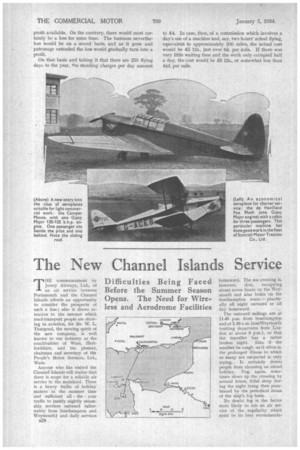Charter Work and Its Cost
Page 41

Page 42

If you've noticed an error in this article please click here to report it so we can fix it.
THERE is ample choice of suitable machines for the lighter air-taxi work. Taking, as a principal objective, that of catering for the business man who is likely, in the majority of cases, to wish to travel either alone or with one companion, two-passenger aeroplanes will best meet the need. The de Havilland Leopard Moth and Fox Moth, the Percival Gull, or the new CompelMouse. are typical examples. A scrutiny of the data embodied in the accompanying table discloses that an average figure of £1.000 will be sufficient to acquire a machine having a cruising speed of approximately 100 m.p.h. and a petrol consumption of 6 gallons per hour (equal to about 16 air miles per gallon), the capacity being two passengers plus luggage.
The cost of operating such a machine can be calculated. Depreciation—or obsolescence, which is the more appropriate terra—will total £175 per annum. Insurance will be about the same amount. Interest on first cost (averaged throughout the life of the machine) is £30 per annum. The salary of the pilot may be taken as £550 per annum and aerodrome and landing fees at, say, £50 per annum. The cost of licences and sundries will be £20 per annum. The foregoing are standing charges and total £1,000.
The running costs comprise fuel (about Id. per mile),
Make and model (-) Ts 3-; S se c
To 1 a
6 lt
Comper Mouse de Havilland Fox Moth de Havilland Leopard Moth Miles Hawk (Cabin model) Monospar(metal construction) Percival Gull L 1,375 1,000
1,275 950 1,725 1,475
m.p.h.
130 97 119 140 114 140
lubricating oil (say 0.1d. per mile), and maintenance (about (L8d. per mile). The total is 1.90d. per air mile or, say, 16s. per flying hour.
Clearly the actual cost of any particular journey. depends upon the number of flying hours per annum. If the average be 500 hours per year, then the standing charges are £2 per hour and the total cost £2 16s. per hour,' which, on an average of 100 m.p.h., is equivalent to Old. per mile.
On the other hand, if the actual number of hours flown per annum be only 250, then the standing charges total £4 per hour, the total cost becomes £4 16s. per hour, which is practically 1s. per mile. That, it should be borne in mind, is the bare operating cost of the aeroplane, and it makes no allowance for overhead costs of the business, including management and profit,.
It is, of course, out of the question in a business of this kind to attempt to calculate profitable charges on the basis of the work which offers. In those circumstances the beginner would have to demand preposterous and exorbitant rates for his work, telling his customers that he would eventually reduce charges as his business grew.
The only practical way is to reduce these figures of operating costs to a basis of daily expenditure, taking each day apart and charging accordingly. That would inevitably mean that in the beginning there would be no profit available. On the contrary, there would most certainly be a loss for some time. The business nevertheless would be on a sound basis, and as it grew and patronage extended the loss would gradually turn into a profit.
On that basis and taking it that there are 250 flying dap, to the year, the standing charges per day amount
to 24. In case, then, of a commission which involves a day's use of a machine and, say, two hours' actual flying, equivalent to approximately 200 miles, the actual cost would be 25 12s., just over 6d. per mile. If there was very little waiting time and the work only occupied half a day, the cost would be 23 12s., or somewhat less than 4id. per mile.




























































































